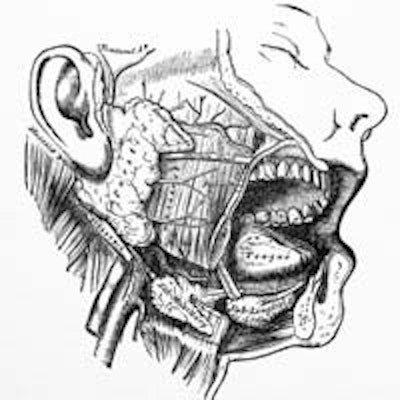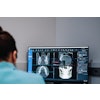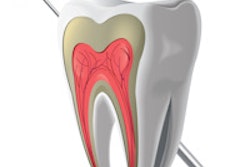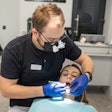
The aging baby boomer generation is bringing with it a number of healthcare concerns, among them an anticipated rise in cancer rates and osteoporosis diagnoses.
What do these two conditions have in common? The increasing use of bisphosphonates to treat osteoporosis, and the role these drugs can play in the development of osteonecrosis of the jaw (ONJ) in cancer patients who undergo chemoradiation therapy.
Dental professionals need to be aware of these risks and complications, and play an active role in the detection, prevention, and treatment of ONJ, according to a new study in Oral Oncology (September 2013, Vol. 49:9, pp. 878-886).
"While the pathogenesis of ONJ is not entirely understood, it continues to remain a possible side effect for patients undergoing treatment for cancer as well as osteoporosis," wrote the study authors, from Roswell Park Cancer Institute and State University of New York at Buffalo. "Since 2003, bisphosphonates have been largely implicated in this oral complication."
In addition to being a standard of treatment for osteoporosis, bisphosphonate-containing drugs are also the standard of care for treating malignancy-associated hypercalcemia, metastatic breast cancer, and multiple myeloma, they noted.
And because cancer patients in general are living longer, they will likely have more exposure to one or more of these medications "throughout their treatment and beyond," meaning the prevalence of ONJ could show a similar increase in the next few decades, the study authors explained.
"With cancer survivorship on the rise, long-term chemotherapeutic side effects are becoming more prevalent, and attention to untoward oral complications cannot be understated," they wrote.
Given this scenario, the researchers wanted to look at whether accepted recommendations for dental clearance prior to head and neck chemoradiation could be used to help prevent and treat drug-induced ONJ.
ONJ risk factors
The researchers outlined several key risk factors for ONJ, including medications, systemic comorbidities, intraoral health conditions, and dental hygiene habits. Drug-related risk factors include the following:
- Intravenous bisphosphonates
- Oral bisphosphonates
- Nonbisphosphonate antiresorptive agents, such as denosumab
- Antiangiogenic agents, such as sunitinib, bevacizumab, lenalidomide, thalidomide, and sorafenib
- Corticosteroids
- Drug combinations involving ONJ medications, chemotherapy drugs, and/or radiation therapy
- Dose, mode, duration, and frequency of exposure to bisphosphonates
Local risk factors include dental interventions, poor oral hygiene, periodontal disease, and periapical pathosis, the researchers noted. Dental procedures that might lead to a higher risk of osteonecrosis include extractions, deep scaling and root planing, laser therapy, and implants.
"Recent case reports suggest that patients exposed to oral bisphosphonates for many years may be considered at high risk of ONJ in the advent of oral trauma and/or surgery," they wrote. "In approximately 60% of ONJ cases reported, oral trauma -- specifically dental extraction -- was identified as a causative factor."
Systemic risk factors include the following:
- Underlying oncologic disease, such as breast cancer, prostate cancer, or multiple myeloma
- Diabetes
- Osteoporosis
- Alcohol and tobacco use
- Advanced age
Before, during treatment
There are several steps a dental professional can take before and during cancer treatment to help patients mediate these risks, the study authors noted, such as clinical and radiographic assessment and comprehensive treatment planning.
"All patients newly diagnosed with multiple myeloma or oncologic disease that has metastasized should be offered a comprehensive dental evaluation," they wrote. "The evaluation should include a panoramic radiograph and, if dentate, a full-mouth series of radiographs to identify any active or potentially active oral infection."
The onset of ONJ may be subtle, they added. "Early changes include nonhealing mucosal ulcers, loose teeth, and soft-tissue infections of nonodontogenic origin. Routine radiographic evaluation for hard-tissue radiolucencies may indicate the onset of early stage ONJ."
Treatment planning should be aggressive to eliminate acute infections and areas of potential infection, the researchers emphasized. Extracting all retained root tips and nonrestorable teeth also is recommended, they noted, and partially erupted third molars and impacted molars associated with odontogenic cysts must also be considered. Timing of oral surgery procedures should allow proper mucosalization of the surgical sites -- about three weeks.
Once cancer treatment has started, "patients at higher risk for ONJ should be placed on short follow-up intervals in order to maintain oral health and identify necrosis at the earliest stage possible," the study authors wrote. Dentate patients should be scheduled for prophylaxis every three months, they noted.
They also had recommendations for patients on antiresorptive medications who need invasive intraoral procedures:
- Adhere to the radiation therapy decision-making model.
- Avoid dental extractions.
- If endodontic therapy is needed, avoid overinstrumentation of the canal and trauma to the periodontium.
- Consult with the treating medical oncologist to determine the optimal time frame for resolving dental pathosis and whether a drug holiday should be considered if extractions are required.
- During the predental intervention period, palliative treatment -- including antibiotic and analgesic prescriptions -- should be used to address symptoms.
Additional care should be taken with patients who present with drug-related ONJ, the researchers noted.
"Patients may present to oral health professionals with an area of exposed bone that is asymptomatic and associated with known risk factors for ONJ," they wrote. "More frequently, however, patients present with pain or suppuration with a history of trauma or dental extraction that failed to heal and a known history of drugs associated with osteonecrosis of the bone."
Long-term goals
In general, the researchers recommend conservative management and treatment options for these patients, such as chlorhexidine rinses, systemic antibiotics, and pain medications. If palliative measures are unsuccessful and necrosis progresses, consider consulting with an infectious disease specialist or possibly referring the patient to a head and neck surgeon, they added.
"Due to the current lack of evidence regarding the etiology of ONJ, as well as lack of clinical trials with regard to its prevention, there are no currently accepted guidelines for referral or treatment," the study authors wrote.
That said, there are two major goals in the prevention of ONJ and radiation-induced osteonecrosis of the jaw. The first involves aggressive elimination of all active oral infections and prevention of any in the future. In addition, "the patient must be educated in his or her role in this process. Without compliance, the possibility of this complication may increase, leading to treatment delays as well as diminished quality of life," the researchers concluded.


















